Although most people are unaware of it, the process of making cars had an equally huge impact on the industry, changing how people lived, worked, and spent their free time. The vehicle was not created by Henry Ford. The car assembly line wasn’t even created by him. Yet more than any other person, he was in charge of turning the vehicle from an unutilized idea into a major innovation that profoundly influenced the 20th century and still has an impact on our lives today. The automotive business and the idea of manufacturing as a whole were completely transformed on December 1, 1913, when Henry Ford invented the assembly line at his Highland Park factory.
One of Henry Ford’s most valuable skills was his ability to recognize and draw in exceptional people, and the early history of Ford Motor Company serves as an example. He recruited a core group of capable, young men who shared his vision and would turn Ford Motor Company into one of the greatest industrial conglomerates in history. The Model A, the new company’s initial automobile, was followed by other improved variants. Ford’s four-cylinder, $600 Model N became the most popular vehicle in the nation in 1907. Ford’s aim for a better, more affordable “motorcar for the large multitude” had grown by this point. He created the Model T with the help of a select group of workers, which was unveiled on October 1, 1908.
The Ford Motor Company
Henry Ford was hardly a novice to the auto manufacturing industry. His first automobile, which he dubbed the “Quadricycle,” was created in 1896. He formally established the Ford Motor Corporation in 1903, and the first Model T was unveiled five years later.
Ford built nine different car models, but even though the Model T was the ninth, it was the first to enjoy widespread popularity. The Model T is still regarded as an iconic vehicle by the still-existing Ford Motor Company.
Building the Model T for a bargain
Making cars for the masses was Henry Ford’s mission. He wanted them to be strong and affordable, and the Model T was his response to that idea. Ford eliminated options and extras from the Model T in an effort to produce them initially more affordably. Customers were unable to select any paint colors because they were all black. The cars would, however, come in a wide range of colors and with a vast range of bespoke bodies by the time production was complete.
Highland Park Plant
Ford constructed a new facility in Highland Park, Michigan, in 1910 with the intention of improving Model T production capacity. He designed a structure that could be quickly expanded to accommodate new industrial techniques.
Ford sought advice from Frederick Taylor, the father of scientific management, on the most effective production techniques. Ford was inspired by the conveyor belt system that was typical in many grain warehouses in that region as well as the assembly line concept that he had previously seen in slaughterhouses in the Midwest. In order to build a new system in his own factory, he wanted to merge these concepts into the knowledge Taylor had provided.
Gravity slides were one of the first manufacturing improvements that Ford introduced, making it easier to move items from one work area to another. The first large-scale assembly line was formally put into operation on December 1, 1913, after other cutting-edge methods were added over the course of the following three years.
Assembly Line Function
In order to allow Model T parts to navigate the assembly process, the moving assembly line appeared to the onlooker to be an unending system of chains and links. A total of 84 steps might be used to breakdown the car’s manufacturing process. Having interchangeable parts, however, was essential to the process.
Unlike other automobiles of the era, every Model T built on Ford’s production line utilized the exact identical valves, petrol tanks, tires, etc. so that they could be put together quickly and efficiently. Mass amounts of parts were produced, and they were then delivered right to the assembly station’s qualified personnel.
A chain conveyor pulled the car’s chassis down a 150-foot line, and 140 workers then attached their allocated parts to the chassis. The number of times employees had to leave their stations to obtain parts was decreased since other workers provided more supplies to the assemblers to keep them stocked. The assembly line drastically reduced the time needed to assemble each vehicle and enhanced profit.
Assembly Line Customization
Ford employed assembly lines more creatively throughout time than he is typically given credit for. He adjusted output to significant demand swings using a number of parallel lines operating in a start-stop mode. Additionally, he employed supporting systems that improved supply chain processes for extraction, transportation, production, assembly, distribution, and sales.
His discovery of a method to automate manufacturing while still allowing each Model T to be individually customized as it rolled off the assembly line was perhaps his most important and underappreciated invention. A chassis, or basic platform, was used in the construction of the Model T and included an engine, pedals, switches, suspensions, wheels, a transmission, a gas tank, a steering wheel, lights, etc. This platform was being developed continuously. However, the car’s body might be any number of different sorts of vehicles, including an auto, truck, racer, woody wagon, snowmobile, milk wagon, police wagon, ambulance, etc. At its height, there were 5,000 custom gadgets made by outside companies that clients could choose from, along with eleven base model bodies.




